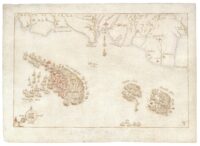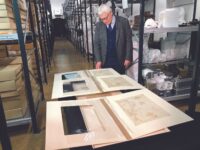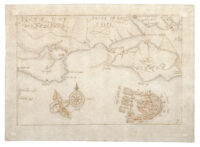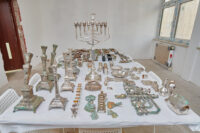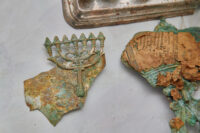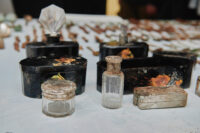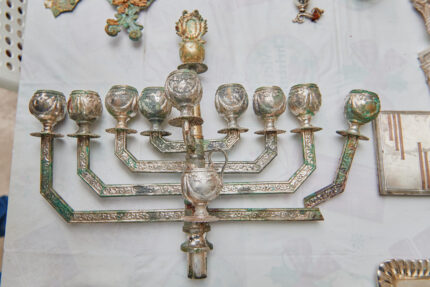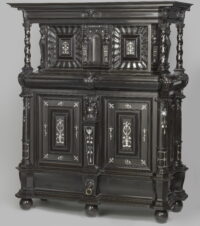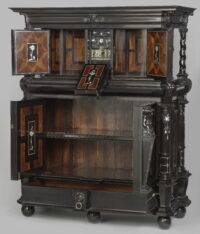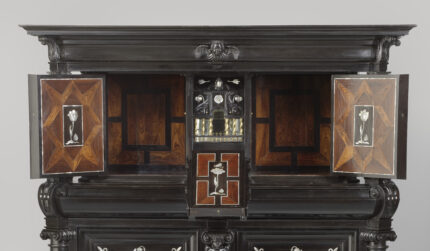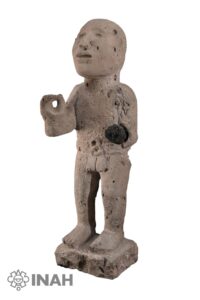 A Late Postclassic period (1200-1521 A.D.) sculpture unearthed in Mexico City last year has gone on public display for the first time in the Templo Mayor Museum. The statue is 69 cm (27 inches) high, 22.5 cm (8.9 inches) wide and 15.3 cm (6 inches) thick and carved from andesite, a quartz-rich volcanic stone. It depicts an anthropomorphic figure with his right arm bent upwards and hand cupped in launching position. The left arm has a nail embedded in it where a chimalli (shield) would have once been mounted.
A Late Postclassic period (1200-1521 A.D.) sculpture unearthed in Mexico City last year has gone on public display for the first time in the Templo Mayor Museum. The statue is 69 cm (27 inches) high, 22.5 cm (8.9 inches) wide and 15.3 cm (6 inches) thick and carved from andesite, a quartz-rich volcanic stone. It depicts an anthropomorphic figure with his right arm bent upwards and hand cupped in launching position. The left arm has a nail embedded in it where a chimalli (shield) would have once been mounted.
Archaeologists believe it is a representation of a deity, perhaps the god of spring and rebirth Xipe Totec, the “Flayed Lord” who wears a suit of flayed skin from sacrifice victims. Coincidentally (or is it?), the sculpture was discovered on March 3rd, during the period of the annual Tlacaxipehualiztli festival that celebrated the regeneration of spring with the sacrifice of numerous war prisoners.
 The statue was found in the Moyotlan quadrant of the Mexica capital of Tenochtitlan. Built on the shallow, brackish Lake Texcoco, Tenochtitlan was connected to the mainland by bridges and four causeways which divided the city into four zones. Moyotlan was the southwest quadrant of the city and is believed to have been the largest of the four. These zones were all distinct political entities with separate legal administrations, dynastic rulers and cultural identities. Xipe Totec was the patron deity of Moyotlan’s Yopico neighborhood.
The statue was found in the Moyotlan quadrant of the Mexica capital of Tenochtitlan. Built on the shallow, brackish Lake Texcoco, Tenochtitlan was connected to the mainland by bridges and four causeways which divided the city into four zones. Moyotlan was the southwest quadrant of the city and is believed to have been the largest of the four. These zones were all distinct political entities with separate legal administrations, dynastic rulers and cultural identities. Xipe Totec was the patron deity of Moyotlan’s Yopico neighborhood.
It was discovered last year during an excavation on Las Delicias Street in the historic center of Mexico City. Extremities of the statue were broken but present, giving restorers the opportunity to put him back on his feet and rebuild his launching arm. He was saved from a far worse fate by being buried under three layers of adobe fill. It may have been deliberately hidden there by indigenous people after the Spanish invasion.
During the presentation of the sculpture, the director of the Museo del Templo Mayor, Patricia Ledesma Bouchan, emphasized: “We want to underline how powerful the sculptures were for the Mexicas: the process that followed their elaboration and the sacredness that covered them, since they were not they were just figures but representations of the gods. Reasons enough for many indigenous people to risk their lives to save these pieces, which are now a source for learning about our past and admiring pre-Hispanic artistic talent.”
The restored sculpture is now on display in the lobby of the museum where it will remain until April 2nd.
